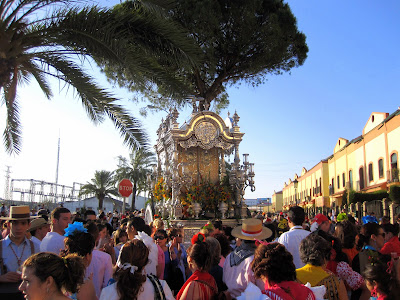
Shannon decided to take time off from chasing rainbows in Ireland to experience the siesta fiesta lifestyle in Spain.

I was so excited for Shannon to come down and see for herself what my life had been like for the past 8 months. I try to explain and describe everything but people really just need to see and experience these place for themselves.
We spent a weekend in Sevilla and just in time for Shannon’s arrival the weather decided to turn a blistering 100 degrees. Sevilla in the spring time is absolutely gorgeous and my favorite place in Spain.
 Shannon got to try the delicious churros con chocolate (remember in the beginning of the year when I tried for days to get a taste of this delicious treat?!)
Shannon got to try the delicious churros con chocolate (remember in the beginning of the year when I tried for days to get a taste of this delicious treat?!)
She stayed for the week with me in La Palma. She met my roommate, she came to school with me and met other teachers and sudents. She got to sit in on my classes and she even helped me with lessons because all the students wanted to hear her talk and to know more about her. The student’s practiced a lot of the vocabulary and sentences they had learned throughout the year. They asked her all sorts of questions about where she is from, the things she likes, and about our family. Everyone loved her and wanted to take pictures of the 2 of us together. During the recess one day, Shannon and I walked out onto the playground and children came running from all sides and surrounded us. It was like a mob. Everyone wanted to touch her, talk to her, listen to her talk, listen to us talk to each other and watch us. Shannon almost fell down. We were surrounded by probably 50 boys and girls. Shannon’s face was priceless. I just laughed grabbed her arm and pulled her through the crowd to safety.

Shannon got to meet Guadalupe which was very important to me. Guadalupe invited us over for lunch one day and we joked that Shannon would never be able to live here because she didn’t like any of the food. We walked around my cute little town and she experienced the small town environment because all the students would yell “Hello teacher Amanda, hello sister Shannon.”
Shannon got to come to Huelva City with me for a night and meet all the American’s I had been hanging out with and traveling with over the course of the year. We went out for a “typical” Spanish night which didn’t begin until 1am and ended close to 6am. We both started the night out in heels and ended the night in the flip flops we had stashed in our purses.

When we went back to La Palma we arrived just in time to see one of the street parade’s that is traditional in my town. There are 2 rival streets and based on where your family lives you are either Calle Cabo or Calle Sevilla. This Sunday happened to be Calle Cabo. Shannon got to see men, women and children dressed in flamenco, riding around in carriages and singing typical songs. The whole town was out in the streets and as we walked along the parade route many teachers, students and parents recognized us.

Some of my favorite parts of Shannon visiting were listening to her try to speak Spanish. I give her credit for trying but she sounded like the most American girl trying to speak Spanish. It was hilarious. She would say hola but pronounce the ‘h’. She would say grass-e-ass, and she was still using her favorite word that she learned in Barcelona, bocadillo, for sandwich. But in her defense no one she met could pronounce her name correctly. The ‘sh’ sound in very difficult for them to make and then the ‘nonn’ part was impossible. Basically they could make the ‘a’ sound in the middle.


A lot of times teachers, students, and members of the community would want to talk to Shannon so they would say something to her in Spanish, I would tell them she doesn’t speak any Spanish, but they continued to talk to her. She just stared at them with a blank look on her face. When someone would ask her a question in Spanish she would look at me and I would either translate or answer the question for Shannon. I did my best to translate back and forth but a lot of the time I would accidently just repeat what they had asked again in Spanish. And then Shannon would just look at me with a blank stare. It was always quite the ordeal!

Overall the trip was very successful. We got to spend a lot of sister time together and I was thrilled to show Shannon all the reasons why I had fallen in love with Spain. It was sad to say bye to Shannon but she was headed back to Ireland where she fit in and clearly belonged. We have both found second homes for ourselves half way around the world from our actual home. I’m really proud of both of us for the adventures we have taken.


























